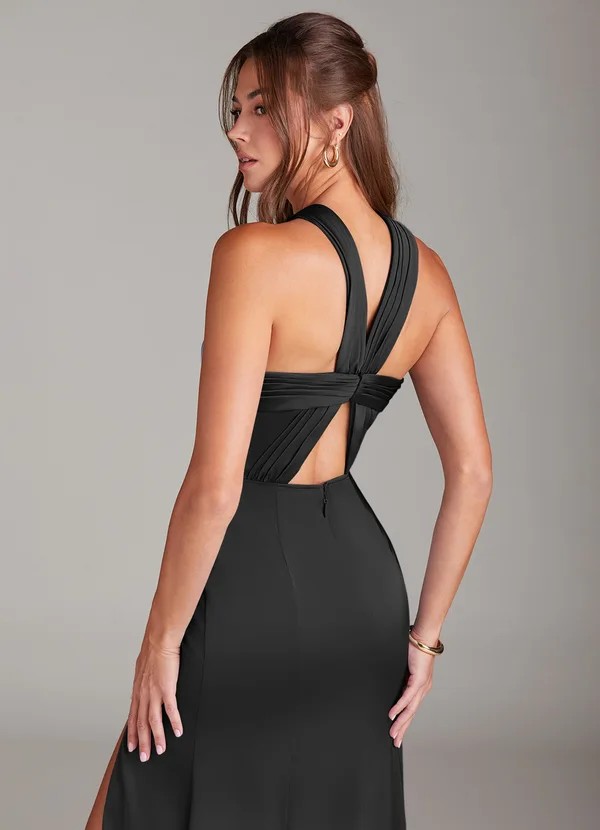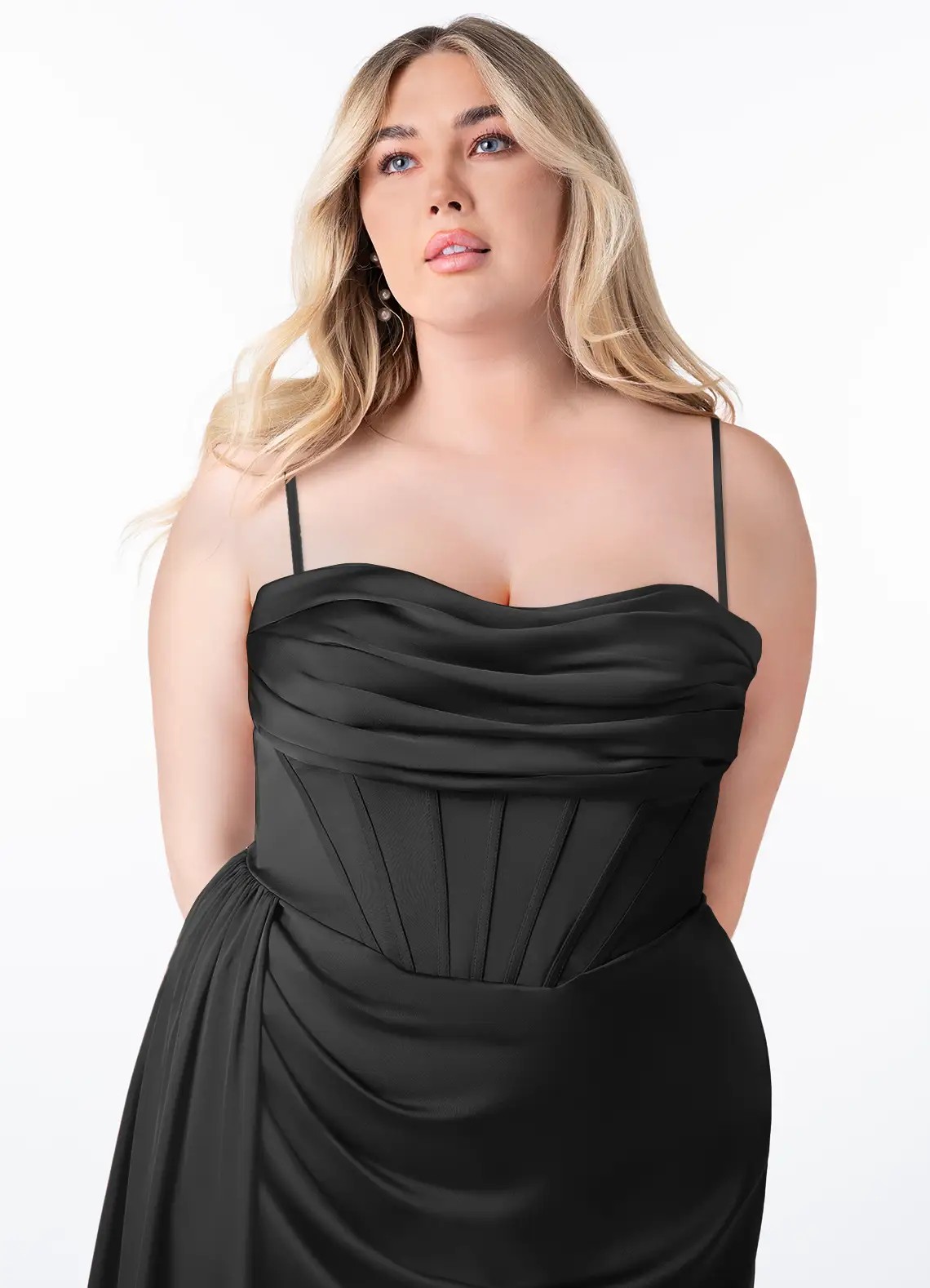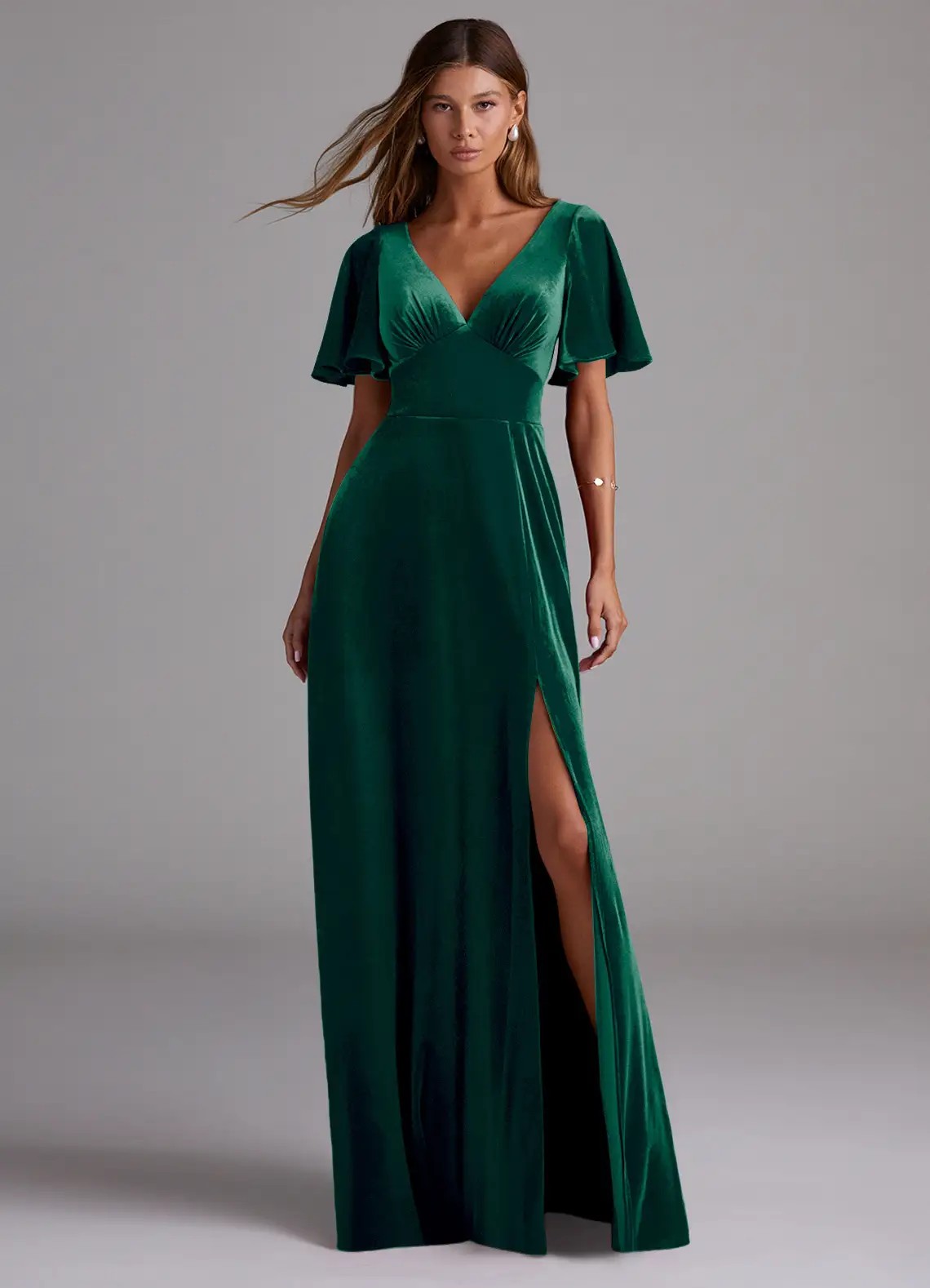How do I find a bridesmaid dress that fits my body shape?

Finding a bridesmaid dress that fits your body shape starts with knowing your body type. Measure bust, waist, and hips to identify if you’re pear, apple, hourglass, or rectangle shaped.
A-line dresses fit most body shapes well. Empire waists suit apple shapes, while wrap styles flatter hourglass figures. Allow 2-3 fittings over 4-6 weeks for proper alterations.
Body Shape & Best Silhouette Guide
| Body Shape | Key Features | Best Silhouettes | Avoid | Neckline Tips |
| Pear | Narrow shoulders, wider hips | A-line, fit-and-flare | Mermaid, trumpet | V-neck, off-shoulder |
| Apple | Fuller midsection, slim legs | Empire, A-line | Fitted waist, bodycon | V-neck, sweetheart |
| Hourglass | Balanced bust and hips, defined waist | Sheath, wrap, mermaid | Empire, drop waist | Sweetheart, square |
| Rectangle | Similar bust, waist, hip measurements | Fit-and-flare, wrap | Straight column | Halter, asymmetric |
| Inverted Triangle | Broad shoulders, narrow hips | A-line, ball gown | Halter, strapless | V-neck, scoop |
Step 1: Measure Your Body Accurately
Taking Your Measurements
Bust Measurement:
- Wear the bra you’ll use on the wedding day
- Measure around the fullest part of your chest
- Keep tape parallel to the floor
- Record in inches to the nearest half-inch
Waist Measurement:
- Find your natural waistline (bend to the side, crease is your waist)
- Measure without pulling the tape tight
- Don’t suck in your stomach
- Stand naturally and breathe normally
Hip Measurement:
- Measure around the fullest part of your hips and bottom
- Stand with feet together
- Keep tape straight across your back
- Record this as your hip size
Understanding Your Shape
Calculate your proportions using these measurements. Compare bust to hips first, then see where your waist sits.
If hips measure 2+ inches larger than bust, you have a pear shape. If bust and hips are within 1 inch and waist is 8+ inches smaller, you’re hourglass shaped.
Step 2: Identify Your Body Shape

Pear Shape (Triangle)
Characteristics:
- Hips wider than shoulders
- Smaller bust
- Defined waist
- Weight carried in hips and thighs
Best Features to Highlight:
- Upper body and shoulders
- Waist definition
- Neckline and decolletage
Apple Shape (Round)
Characteristics:
- Fuller midsection
- Bust and waist similar measurements
- Slimmer legs
- Weight carried in stomach area
Best Features to Highlight:
- Legs
- Shoulders and arms
- Bust line
Hourglass Shape
Characteristics:
- Bust and hips nearly equal
- Waist 8+ inches smaller than bust/hips
- Balanced proportions
- Curves in bust and hip area
Best Features to Highlight:
- Natural waist
- Curves
- Balanced silhouette
Rectangle Shape (Athletic)
Characteristics:
- Bust, waist, hips within 2 inches
- Straight up and down
- Little waist definition
- Athletic build
Best Features to Highlight:
- Shoulders
- Legs
- Arms
Inverted Triangle Shape
Characteristics:
- Shoulders broader than hips
- Larger bust
- Slim hips and legs
- Athletic upper body
Best Features to Highlight:
- Legs
- Hips
- Lower body
Step 3: Choose the Right Silhouette
A-Line Dresses
Best For: Pear, apple, rectangle shapes
Why It Works:
- Fitted at bust, flows from waist
- Skims hips without clinging
- Creates balanced proportions
- Comfortable for all-day wear
Styling Tips:
- Pair with V-neck for apple shapes
- Add off-shoulder straps for pear shapes
- Choose knee-length or floor-length options
Empire Waist Dresses
Best For: Apple, pear shapes
Why It Works:
- Seam sits just below bust
- Flows over midsection
- Elongates the body
- Draws attention upward
Styling Tips:
- Choose soft, drapey fabrics
- Avoid bulky waistbands
- Opt for V or sweetheart necklines
Sheath Dresses
Best For: Hourglass, rectangle shapes
Why It Works:
- Follows body lines closely
- Showcases natural curves
- Clean, modern silhouette
- Works for formal events
Styling Tips:
- Add a belt to create waist definition for rectangles
- Choose stretch fabrics for comfort
- Keep length at knee or floor
Fit-and-Flare Dresses
Best For: Rectangle, pear, hourglass shapes
Why It Works:
- Fitted bodice to waist
- Flares at hips
- Creates curves for rectangles
- Balances proportions for pears
Styling Tips:
- Highlight waist with seam or belt
- Choose full skirts for more flare
- Works well in tea-length
Mermaid & Trumpet Styles
Best For: Hourglass shapes
Why It Works:
- Hugs curves through hips
- Flares at knee or mid-thigh
- Showcases balanced figure
- Dramatic, formal look
Styling Tips:
- Requires confidence in your curves
- Not ideal for apple or pear shapes
- Best in stretch fabrics
Wrap Dresses
Best For: Hourglass, apple, rectangle shapes
Why It Works:
- Adjustable fit
- Creates waist definition
- Flatters bustline
- Versatile style
Styling Tips:
- Tie at natural waist
- Choose medium-weight fabrics
- Avoid overly clingy materials
Fabric Choices by Body Shape

| Fabric Type | Best For | Characteristics | Avoid If |
| Chiffon | All shapes | Light, flowy, forgiving | None |
| Satin | Hourglass, rectangle | Structured, smooth | Apple, pear (clings) |
| Jersey | All shapes | Stretch, comfortable | None |
| Lace | Hourglass, pear | Textured, romantic | Apple (adds bulk) |
| Tulle | Pear, rectangle | Adds volume, structured | Inverted triangle |
| Crepe | Hourglass, rectangle | Smooth, drapes well | Very curvy figures |
Fabric Weight Matters
Lightweight Fabrics (Chiffon, Jersey):
- Skim over problem areas
- Move naturally with body
- Comfortable in warm weather
- Best for flowy silhouettes
Medium-Weight Fabrics (Crepe, Satin):
- Provide structure and support
- Hold shape well
- Work for fitted styles
- Year-round versatility
Heavier Fabrics (Brocade, Heavy Satin):
- Create dramatic looks
- Can add bulk
- Best for formal winter events
- May require more alterations
Step 4: Consider Dress Length
Floor-Length Gowns
Best For: All body shapes, formal weddings
Benefits:
- Elongates the body
- Most formal option
- Hides shoes and legs
- Classic bridesmaid look
Fitting Notes:
- Hem must be adjusted to height
- Add 2-3 inches for heels
- Budget extra time for alterations
Tea-Length (Mid-Calf)
Best For: Rectangle, pear shapes, shorter bridesmaids
Benefits:
- Shows off legs
- Vintage, playful vibe
- Less formal than floor-length
- Easier to walk in
Best Paired With:
- Heels or dressy flats
- Simple accessories
- Summer or outdoor weddings
Knee-Length
Best For: Rectangle, hourglass shapes
Benefits:
- Most casual option
- Comfortable for dancing
- Affordable alterations
- Works for daytime weddings
Consider:
- May emphasize heavy calves
- Not ideal for very formal events
- Choose A-line or fit-and-flare
Step 5: Plan Your Fitting Schedule
Timeline for Perfect Fit
10 Weeks Before Wedding:
- Order bridesmaid dress
- Provide accurate measurements
- Choose size based on largest measurement
- Order from reliable source with reviews
4-6 Weeks Before:
- Receive dress and inspect immediately
- Try on with proper undergarments
- Schedule first fitting appointment
- Note any concerns about fit
First Fitting (4-5 Weeks Out):
- Bring the shoes you’ll wear
- Wear the right undergarments
- Have seamstress pin hem, sides, straps
- Discuss any comfort issues
Second Fitting (2-3 Weeks Out):
- Check all pinned alterations
- Test mobility (sitting, dancing, raising arms)
- Ensure comfort for 6-8 hour wear
- Approve final adjustments
Final Pickup (1 Week Out):
- Pick up altered dress
- Try on one last time
- Check all seams and hems
- Hang or store properly
Common Alterations by Body Shape
Pear Shape:
- Taking in waist and bust
- Letting out hips slightly
- Adjusting hem length
Apple Shape:
- Adding darts for waist definition
- Adjusting bust fit
- Hemming length
Hourglass Shape:
- Taking in waist significantly
- Minimal hip adjustments
- Bust alterations for support
Rectangle Shape:
- Creating waist definition with seams
- Adjusting overall fit evenly
- Adding structure at bodice
Undergarment Guide by Dress Style

Strapless & Sweetheart Dresses
Essential Undergarments:
- Strapless bra with grip
- Silicone strips for security
- Shapewear if desired
Fitting Tips:
- Bra should not show above dress
- Test by raising arms overhead
- Avoid low-back styles with standard bras
Plunge & V-Neck Styles
Essential Undergarments:
- Plunge bra or adhesive cups
- Fashion tape for neckline
- Low-profile shapewear
What to Avoid:
- Full-coverage bras
- Visible straps or bands
- Bulky shapewear under thin fabric
Backless & Low-Back Dresses
Essential Undergarments:
- Adhesive bras or cups
- Low-back converter straps
- Stick-on nipple covers
Support Options:
- Built-in bust support
- Dress with internal boning
- Professional alterations for support
Sheer & Illusion Necklines
Essential Undergarments:
- Nude or skin-tone bras
- Seamless shapewear
- No visible lines or straps
Color Matching:
- Match to your skin, not dress color
- Test under different lighting
- Avoid white under sheer fabric
Shopping Tips for Different Body Shapes
For Pear Shapes
What to Look For:
- Embellished or detailed bodices
- Off-shoulder or boat neck styles
- A-line or fit-and-flare skirts
- Dark colors on bottom, lighter on top
Fitting Room Test:
- Sit down and check hip comfort
- Bend forward to test waist coverage
- Walk around to feel skirt movement
For Apple Shapes
What to Look For:
- Empire or raised waistlines
- V-neck or wrap styles
- Vertical details and seams
- Flowy fabrics that skim
Fitting Room Test:
- Check side profile in mirror
- Ensure no pulling across midsection
- Sit to test comfort around waist
For Hourglass Shapes
What to Look For:
- Defined waist seams
- Wrap or belted styles
- Stretchy, forgiving fabrics
- Fitted bodices
Fitting Room Test:
- Check that waist hits correctly
- Ensure bust has proper support
- Hips should not pull or gap
For Rectangle Shapes
What to Look For:
- Fit-and-flare silhouettes
- Belted or ruched waists
- Textured or layered fabrics
- Asymmetric details
Fitting Room Test:
- Look for created waist definition
- Check overall proportion balance
- Ensure dress doesn’t hang straight
For Inverted Triangle Shapes
What to Look For:
- A-line or ball gown skirts
- V-neck or scoop necklines
- Detailed or voluminous skirts
- Minimal shoulder embellishment
Fitting Room Test:
- Check shoulder seam placement
- Ensure skirt balances upper body
- Verify neckline isn’t too wide
Frequently Asked Questions
What if I’m between two body shapes?
Many people have characteristics of two body shapes. Focus on your most prominent feature when choosing a dress silhouette.
If you’re between pear and hourglass, emphasize your waist with fitted styles. Between rectangle and inverted triangle, choose dresses that create balance with A-line skirts.
How do I know what size bridesmaid dress to order?
Order based on your largest measurement. If your hips are 2 inches larger than your bust, order the hip size.
Dresses can be taken in at the smaller areas during alterations. It’s easier to make a dress smaller than larger. Always check the brand’s specific size chart.
Can I wear shapewear under a bridesmaid dress?
Yes, shapewear works under most bridesmaid dresses. Choose seamless, skin-tone options that won’t show under your fabric.
Avoid shapewear that creates visible lines or bulges. Test it during your fitting to ensure comfort for 6-8 hours. High-waist styles work best under fitted dresses.
Should I lose weight before ordering my bridesmaid dress?
Order your dress based on your current measurements. Significant weight changes can require extensive alterations or reordering.
If you’re actively working on fitness, wait until 10-12 weeks before the wedding to order. Maintain stable weight in the final 8 weeks before fittings.
How many fittings do I need for a bridesmaid dress?
Most bridesmaids need 2-3 fittings over 4-6 weeks. The first fitting happens 4-5 weeks before the wedding for pinning.
The second fitting checks those alterations 2-3 weeks out. A third fitting may be needed for complex adjustments or significant alterations. Simple hem-only changes may need just one fitting.
What if the dress doesn’t fit my body shape well?
Alterations can significantly improve fit for any body shape. A skilled seamstress can add darts, take in seams, or adjust the silhouette.
For major fit issues, consider adding a belt, changing the neckline, or adjusting straps. Communicate concerns early so the bride can help find solutions or alternative styles.